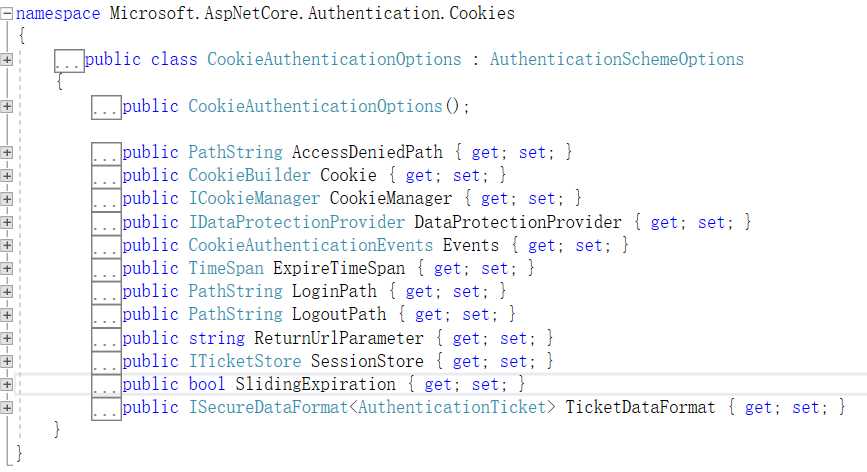标签:接下来 out height exce 传递 action defaults tsig result
我的朋友问我cookie是什么,用来干什么的,可是我居然无法清楚明白简短地向其阐述cookie,这不禁让我陷入了沉思:为什么我无法解释清楚,我对学习的方法产生了怀疑!所以我们在学习一个东西的时候,一定要做到知其然知其所以然。
HTTP协议本身是无状态的。什么是无状态呢,即服务器无法判断用户身份。Cookie实际上是一小段的文本信息)。客户端向服务器发起请求,如果服务器需要记录该用户状态,就使用response向客户端浏览器颁发一个Cookie。客户端浏览器会把Cookie保存起来。当浏览器再请求该网站时,浏览器把请求的网址连同该Cookie一同提交给服务器。服务器检查该Cookie,以此来辨认用户状态。
打个比方,这就犹如你办理了银行卡,下次你去银行办业务,直接拿银行卡就行,不需要身份证。
废话不多说,干就完了,现在我们创建ASP.NET Core MVC项目,撰写该文章时使用的.NET Core SDK 3.0 构建的项目,创建完毕之后我们无需安装任何包,
但是我们需要在Startup中添加一些配置,用于Cookie相关的。
//public const string CookieScheme = "YourSchemeName"; public Startup(IConfiguration configuration) { Configuration = configuration; } public IConfiguration Configuration { get; } // This method gets called by the runtime. Use this method to add services to the container. public void ConfigureServices(IServiceCollection services) { //CookieAuthenticationDefaults.AuthenticationScheme Cookies Default Value //you can change scheme services.AddAuthentication(CookieAuthenticationDefaults.AuthenticationScheme) .AddCookie(options => { options.LoginPath = "/LoginOrSignOut/Index/"; }); services.AddControllersWithViews(); // is able to also use other services. //services.AddSingleton<IConfigureOptions<CookieAuthenticationOptions>, ConfigureMyCookie>(); }
在其中我们配置登录页面,其中 AddAuthentication 中是我们的方案名称,这个是做什么的呢?很多小伙伴都懵懵懂懂表示很懵逼啊,我看很多人也是都写得默认,那它到底有啥用,经过我看AspNetCore源码发现它这个是可以做一些配置的。看下面的代码:
internal class ConfigureMyCookie : IConfigureNamedOptions<CookieAuthenticationOptions> { // You can inject services here public ConfigureMyCookie() {} public void Configure(string name, CookieAuthenticationOptions options) { // Only configure the schemes you want //if (name == Startup.CookieScheme) //{ // options.LoginPath = "/someotherpath"; //} } public void Configure(CookieAuthenticationOptions options) => Configure(Options.DefaultName, options); }
在其中你可以定义某些策略,随后你直接改变 CookieScheme 的变量就可以替换某些配置,在配置中一共有这几项,这无疑是帮助我们快速使用Cookie的好帮手~点个赞。

在源码中可以看到Cookie默认保存的时间是14天,这个时间我们可以去选择,支持TimeSpan的那些类型。
public CookieAuthenticationOptions() { ExpireTimeSpan = TimeSpan.FromDays(14); ReturnUrlParameter = CookieAuthenticationDefaults.ReturnUrlParameter; SlidingExpiration = true; Events = new CookieAuthenticationEvents(); }
接下来LoginOrOut Controller,我们模拟了登录和退出,通过 SignInAsync 和 SignOutAsync 方法。
[HttpPost] public async Task<IActionResult> Login(LoginModel loginModel) { if (loginModel.Username == "haozi zhang" && loginModel.Password == "123456") { var claims = new List<Claim> { new Claim(ClaimTypes.Name, loginModel.Username) }; ClaimsPrincipal principal = new ClaimsPrincipal(new ClaimsIdentity(claims, "login")); await HttpContext.SignInAsync(principal); //Just redirect to our index after logging in. return Redirect("/Home/Index"); } return View("Index"); } /// <summary> /// this action for web lagout /// </summary> [HttpGet] public IActionResult Logout() { Task.Run(async () => { //注销登录的用户,相当于ASP.NET中的FormsAuthentication.SignOut await HttpContext.SignOutAsync(); }).Wait(); return View(); }
就拿出推出的源码来看,其中获取了Handler的某些信息,随后将它转换为 IAuthenticationSignOutHandler 接口类型,这个接口 as 接口,像是在地方实现了这个接口,然后将某些运行时的值引用传递到该接口上。
public virtual async Task SignOutAsync(HttpContext context, string scheme, AuthenticationProperties properties) { if (scheme == null) { var defaultScheme = await Schemes.GetDefaultSignOutSchemeAsync(); scheme = defaultScheme?.Name; if (scheme == null) { throw new InvalidOperationException($"No authenticationScheme was specified, and there was no DefaultSignOutScheme found. The default schemes can be set using either AddAuthentication(string defaultScheme) or AddAuthentication(Action<AuthenticationOptions> configureOptions)."); } } var handler = await Handlers.GetHandlerAsync(context, scheme); if (handler == null) { throw await CreateMissingSignOutHandlerException(scheme); } var signOutHandler = handler as IAuthenticationSignOutHandler; if (signOutHandler == null) { throw await CreateMismatchedSignOutHandlerException(scheme, handler); } await signOutHandler.SignOutAsync(properties); }
其中 GetHandlerAsync 中根据认证策略创建了某些实例,这里不再多说,因为源码深不见底,我也说不太清楚...只是想表达一下看源码的好处和坏处....
public async Task<IAuthenticationHandler> GetHandlerAsync(HttpContext context, string authenticationScheme) { if (_handlerMap.ContainsKey(authenticationScheme)) { return _handlerMap[authenticationScheme]; } var scheme = await Schemes.GetSchemeAsync(authenticationScheme); if (scheme == null) { return null; } var handler = (context.RequestServices.GetService(scheme.HandlerType) ?? ActivatorUtilities.CreateInstance(context.RequestServices, scheme.HandlerType)) as IAuthenticationHandler; if (handler != null) { await handler.InitializeAsync(scheme, context); _handlerMap[authenticationScheme] = handler; } return handler; }
最后我们在页面上想要获取登录的信息,可以通过 HttpContext.User.Claims 中的签名信息获取。
@using Microsoft.AspNetCore.Authentication <h2>HttpContext.User.Claims</h2> <dl> @foreach (var claim in User.Claims) { <dt>@claim.Type</dt> <dd>@claim.Value</dd> } </dl> <h2>AuthenticationProperties</h2> <dl> @foreach (var prop in (await Context.AuthenticateAsync()).Properties.Items) { <dt>@prop.Key</dt> <dd>@prop.Value</dd> } </dl>

三分钟学会在ASP.NET Core MVC 中使用Cookie
标签:接下来 out height exce 传递 action defaults tsig result
原文地址:https://www.cnblogs.com/ZaraNet/p/12099286.html